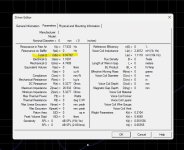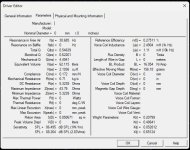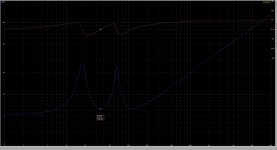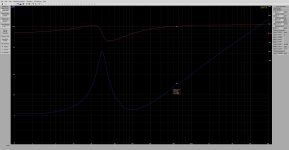Hello,
I'm having a little trouble understanding bass reflex alignments(Qtc) and was wondering if anyone could help me? How do you determine what bass reflex alignment your subwoofer is using (Chebyshev, Quasi-butterworth, etc)? I do have a Dayton Audio DATS V3 that I used to measure my drivers with and the friendly people over at Parts Express said this tool can measure the subwoofer's total Q (Qtc). So I connected the driver to my DATS and then installed it back into the enclosure and ran the sweep. After the sweep was complete I got a Qtc of ".93782" (picture enclosed). I know the picture I uploaded says "Qts" but its actually Qtc because the driver was installed in the enclosure when I ran the sweep. From this data can I determine what kind of bass reflex alignment this subwoofer is using?
Thanks
I'm having a little trouble understanding bass reflex alignments(Qtc) and was wondering if anyone could help me? How do you determine what bass reflex alignment your subwoofer is using (Chebyshev, Quasi-butterworth, etc)? I do have a Dayton Audio DATS V3 that I used to measure my drivers with and the friendly people over at Parts Express said this tool can measure the subwoofer's total Q (Qtc). So I connected the driver to my DATS and then installed it back into the enclosure and ran the sweep. After the sweep was complete I got a Qtc of ".93782" (picture enclosed). I know the picture I uploaded says "Qts" but its actually Qtc because the driver was installed in the enclosure when I ran the sweep. From this data can I determine what kind of bass reflex alignment this subwoofer is using?
Thanks
Attachments
Greets!Hello,
I'm having a little trouble understanding bass reflex alignments(Qtc) and was wondering if anyone could help me? How do you determine what bass reflex alignment your subwoofer is using (Chebyshev, Quasi-butterworth, etc)? I do have a Dayton Audio DATS V3 that I used to measure my drivers with and the friendly people over at Parts Express said this tool can measure the subwoofer's total Q (Qtc). So I connected the driver to my DATS and then installed it back into the enclosure and ran the sweep. After the sweep was complete I got a Qtc of ".93782" (picture enclosed). I know the picture I uploaded says "Qts" but its actually Qtc because the driver was installed in the enclosure when I ran the sweep. From this data can I determine what kind of bass reflex alignment this subwoofer is using?
Thanks
Qtc = closed box, Qtb = reflex 😉 Measurement systems only 'understand' driver's total Q (Qts). As for fitting a particular curve, learned enough speaker design studying the pioneer's designs that I figured it out 'good enough' long before T/S existed, so never bothered.
That said, a max flat reflex = 0.403 Qts/b:
Vented net volume (Vb) (L) = 20*Vas*Qts'^3.3
(Ft^3 = (Vb)/~28.31685)
Vented box tuning (Fb) (Hz) = 0.42*Fs*Qts'^-0.96
F3 (Hz) = Fs*0.28*Qts'^-1.4
(Qts'): (Qts) + any added series resistance (Rs)
From this we see that your driver isn't considered suitable for reflex loading, but like you we build them anyway 😉 and FWIW was my preferred alignment due to normally having to put speakers in corners:
Keele's Extended Bass Shelf (EBS) alignment (Thiele #9.5): Vb = 2.6*Vas, Fb = 0.52*Fs, 0.625 Qts'
That is a bit tricky to do. In the simpler approximations, the bass reflex alignment is determined by the driver's Fs, Vas, and Qts as a bare minimum. The enclosure volume Vb and vent tuning frequency Fb will then serve to determine the alignment. Of course, enclosure losses, typically denoted by QL need to be taken into account, as they somewhat reduce the bass output. If the impedance is to be modelled, then it is also necessary to have values of Qms, Qes, Res, and Lvc, at the first level of approximation.How do you determine what bass reflex alignment your subwoofer is using (Chebyshev, Quasi-butterworth, etc)?
The original 1961 Thiele journal paper covered a lot of different bass reflex alignments that corresponded to particular values of Qts, h=Fb/Fs, and α=Vas/Vb. The Quasi-Butterworth (QB3) alignments generally had values of Qts<0.383, the B4 alignment had a Qts=0.383, and the Chebyshev (C4) alignments had values of Qts>0.383. Of course, when QL<∞, these Qts values are increased a little to compensate for the additional losses in the system.
The figure below is taken from the abovementioned journal paper. It shows the variation in low-frequency response that is representative of the C4, B4, and QB3 alignments. By adjusting the box tuning frequency (Fb) and the box volume (Vb) for any given driver, it is possible to get it to produce a response that is still going to be very useful, but one that does not correspond exactly to any of the "standard" low-frequency alignments.
The DATS V3 can only be used to measure the free-air Thiele–Small parameters of the driver, or the sealed-box (Qtc, Fc, etc.) of a low-frequency enclosure. As far as determining the Thiele–Small parameters of a vented-box low-frequency alignment, it's possible to deduce Fb from the impedance minimum that occurs between the two impedance peaks. As a first approximation, the net volume of the enclosure can be used as Vb when calculating the value of α.I do have a Dayton Audio DATS V3 that I used to measure my drivers with and the friendly people over at Parts Express said this tool can measure the subwoofer's total Q (Qtc).
Note that it is possible to estimate the parameters associated with a bass-reflex low-frequency alignment from the measured impedance response. The measured impedance response would need to include the two impedance resonance peaks, some data close to 0Hz, and some high-frequency impedance data that is affected by the voice-coil inductance behavior.
@Peaches2016 Was that in a sealed enclosure? Or a ported one?So I connected the driver to my DATS and then installed it back into the enclosure and ran the sweep. After the sweep was complete I got a Qtc of ".93782" (picture enclosed).
Can you show us a picture of the impedance sweep that was completed by DATS V3? It would help us to better understand what was going on, and then to tailor any comments accordingly.
This driver, with Qts=0.55, is very well suited to a bass reflex low-frequency alignment. Below is the VituixCAD simulation of this driver in a 174-litre enclosure tuned to 23.0Hz. The −3dB point is approximately 21Hz, which is commendably low and useful in subwoofer applications.Here are the T/S parameters of the raw subwoofer driver if you need them.
Adding a Linkwitz–Riley 4th-order 80Hz low-pass filter produces the following response. Note how flat it is in the passband.
Hello Witwald!
Thank you for the response. I have included two more screenshots, one of the impedance curve of the driver and another with the driver in the box when I was trying to find the port tuning (lowest point between the two humps) of the enclosure. This is a ported enclosure and port tuning is around 35Hz. I was kind of hoping that with this data I could find out the bass alignment, but let me know if there is anything else you need. If you need the internal volume of the cabinet and port dimensions I can provide that as well.
Thanks again!
Thank you for the response. I have included two more screenshots, one of the impedance curve of the driver and another with the driver in the box when I was trying to find the port tuning (lowest point between the two humps) of the enclosure. This is a ported enclosure and port tuning is around 35Hz. I was kind of hoping that with this data I could find out the bass alignment, but let me know if there is anything else you need. If you need the internal volume of the cabinet and port dimensions I can provide that as well.
Thanks again!
Attachments
The vented-box impedance curve does indicate a vent tuned to around 35Hz. The cabinet's internal volume would help to determine an estimate of the low-frequency "alignment" that was selected. The vent dimensions would also be useful for checking the computed value of Fb against the measured value of Fb.
The guy at PE didn't understand what you wanted. They are not specialists or experts, just sales guy's with some acquired knowledge.
Since their official "subwoofer guru" openly stated that PE doesn't care for 20% more or less QTS and other TS parameter of their products, you should take anything they say with some caution. Most of the stuff they sell ends up in some so-so constructions not really done by experts, so 95% of their customers don't care anyway. The remaining 5% are the "know better idiots".
You can not use DATS to measure a vented box alignment. Period.
The good news is, only if you use your subwoofer on top of a 30 feet high pole, the aligment is of audible interest. As soon as you place a cabinet in a room, it's influence makes anything of the tune unrecognizeable.
Measure the parameter of your specific driver using DATS and do a simulation, then build. This will show you what to expect.
No one builds first and measures to find out later, not today, not anymore.
Since their official "subwoofer guru" openly stated that PE doesn't care for 20% more or less QTS and other TS parameter of their products, you should take anything they say with some caution. Most of the stuff they sell ends up in some so-so constructions not really done by experts, so 95% of their customers don't care anyway. The remaining 5% are the "know better idiots".
You can not use DATS to measure a vented box alignment. Period.
The good news is, only if you use your subwoofer on top of a 30 feet high pole, the aligment is of audible interest. As soon as you place a cabinet in a room, it's influence makes anything of the tune unrecognizeable.
Measure the parameter of your specific driver using DATS and do a simulation, then build. This will show you what to expect.
No one builds first and measures to find out later, not today, not anymore.
Well, in fairness, they sometimes do if they're trying to analyse something they already own for one reason or another. And you certainly can use DATS to measure the system impedance of a complete loudspeaker, sealed, vented or otherwise at a small-signal level, although technically speaking you can set v.2 or v.3 to a maximum 11.4dBu (2.88v) nominal rated output. Ideally, you'd do so outside or in an anechoic chamber, but providing you're a reasonable distance from boundary conditions or not loading it some other way, there isn't likely to be any dramatic differences in the basic tuning -at least, I've not found any in direct comparisons. It's actually (like any other impedance measuring tool) quite useful for confirming system tuning at those drive levels, checking for unwanted internal resonances &c., and for those unfamiliar with the process, there is an entire section in its user guide entitled 'Using DATS to Evaluate a Vented Box loudspeaker' which gives a concise explanation about the method and best viewing options.
Last edited:
DATS is a nice, easy to use tool, not cheap, but the best someone new to speaker building can get. You got to learn what your measurement tells you, that's all. Best use it in combination with some simple simulation like WinISD. When you realize how well simulations and measurements fit together, you are on a good way to serious speaker building.
Being able to do serious measurements takes the nonsense out of DIYS and makes you understand the basics.
Being able to do serious measurements takes the nonsense out of DIYS and makes you understand the basics.
Better to understand what the values mean
Then it becomes simple.
Speaker suspension is either considered more tight or loose.
And the magnet is only so strong or weak.
Driver Qts gives you a overall view.
It is total quality. A equation based on the mechanical and electrical properties.
If the number is high like Qts of .5 or .6 or higher.
Usually a weaker magnet or a stiff suspension
Basically it is harder to move, magnet has less control.
Basically tells you the box needs to be real big.
It is already hard enough to move, so a small box makes it worse.
If number is average around .4 good magnet. regardless
if stiff or loose is sized in general good decent control.
Or if it is really low like .3 or .2
Usually regardless if stiff or loose a very powerful magnet.
It is easier to move, the box will be smaller.
"Alignment" is just how closely it matches a flat response
and the low end cutoff matches a filter roll off.
Typical flat alignment considered a Butterworth .707 filter
Hence why common alignments named after filters Butterworth/ Chebyshev
The port eventually is just a hole in the box, when it dont resonate.
So it cancels the signal and that cancelation can be close to a 3rd or 4th order
filter cutoff.
Speaker has a resonant frequency or Fs so Fb or the box tuning will either be
only 3 to 10 Hz below or above that. That is it. To achieve a response that resembles
or "Aligns" to a filter.
Pretty simple, speaker is either this tight or loose, and the magnet is this strong or weak.
So the box needs to be so big or small.
Tuning no mystery or magic. The speaker has a resonant frequency. That is it.
Either 3 to 10 Hz above or below. The higher you tune, the faster it unloads.
Unloading is the port stops resonating, and is literally a hole in the box= leakage.
That is what creates the " cutoff" rate of the " filter" that your aligning the response to.
Qtc or Qtb is telling you if the cutoff Q of the filter your matching is close or not.
Basically if the Q is too high then the box is too small and if too low the box too big.
Your Example was Qtc .9 so it is higher than .7. Means the box is to small.
Done sometimes with subs, makes a over emphasized peak in the response.
To much it sounds boomy or bloomy or rings a long time. Box is small
I usually tolerate no more than .8 in most circumstances.
.7 or .707 considered flat response. .5 about as big as you go.
Basically a Bessel filter. Not really done often cause the box is very large.
Then it becomes simple.
Speaker suspension is either considered more tight or loose.
And the magnet is only so strong or weak.
Driver Qts gives you a overall view.
It is total quality. A equation based on the mechanical and electrical properties.
If the number is high like Qts of .5 or .6 or higher.
Usually a weaker magnet or a stiff suspension
Basically it is harder to move, magnet has less control.
Basically tells you the box needs to be real big.
It is already hard enough to move, so a small box makes it worse.
If number is average around .4 good magnet. regardless
if stiff or loose is sized in general good decent control.
Or if it is really low like .3 or .2
Usually regardless if stiff or loose a very powerful magnet.
It is easier to move, the box will be smaller.
"Alignment" is just how closely it matches a flat response
and the low end cutoff matches a filter roll off.
Typical flat alignment considered a Butterworth .707 filter
Hence why common alignments named after filters Butterworth/ Chebyshev
The port eventually is just a hole in the box, when it dont resonate.
So it cancels the signal and that cancelation can be close to a 3rd or 4th order
filter cutoff.
Speaker has a resonant frequency or Fs so Fb or the box tuning will either be
only 3 to 10 Hz below or above that. That is it. To achieve a response that resembles
or "Aligns" to a filter.
Pretty simple, speaker is either this tight or loose, and the magnet is this strong or weak.
So the box needs to be so big or small.
Tuning no mystery or magic. The speaker has a resonant frequency. That is it.
Either 3 to 10 Hz above or below. The higher you tune, the faster it unloads.
Unloading is the port stops resonating, and is literally a hole in the box= leakage.
That is what creates the " cutoff" rate of the " filter" that your aligning the response to.
Qtc or Qtb is telling you if the cutoff Q of the filter your matching is close or not.
Basically if the Q is too high then the box is too small and if too low the box too big.
Your Example was Qtc .9 so it is higher than .7. Means the box is to small.
Done sometimes with subs, makes a over emphasized peak in the response.
To much it sounds boomy or bloomy or rings a long time. Box is small
I usually tolerate no more than .8 in most circumstances.
.7 or .707 considered flat response. .5 about as big as you go.
Basically a Bessel filter. Not really done often cause the box is very large.
Last edited:
You can also Linkwitz Transform a bass reflex system, https://www.diyaudio.com/community/threads/dsp-assisted-reflex-system.404349/post-7552138, changing whatever you have into whatever you want (within reason).
The vented-box impedance curve does indicate a vent tuned to around 35Hz. The cabinet's internal volume would help to determine an estimate of the low-frequency "alignment" that was selected. The vent dimensions would also be useful for checking the computed value of Fb against the measured value of Fb.
I was hoping there was an easier method then having to calculate the internal volume and port length and then modeling it in WinISD or VituixCAD. Guess not. Internal volume of the cabinet is 1.09 cu feet. Port dimensions is 12.5" wide x 7/8" height x 9.5" length. I haven't modeled it in WinISD yet but I would guess that there is a bump in the response before rolling off considering how small the internal volume is of the cabinet.
The manufacturer of this subwoofer claims a flat response curve but I don't see how that's possible without DSP and this subwoofer doesn't have it.
where you use the subwoofer is in a way more important than subwoofer itself.The manufacturer of this subwoofer claims a flat response curve but I don't see how that's possible without DSP and this subwoofer doesn't have it.
open air vs large room vs small room vs car require different subs.
final response only will match theoretical in open space, like an outdoor concert, and even then only if a single subwoofer is used, which is never the case at those concerts. so basically never.
to get good response in room you simply get the biggest, lowest playing sub and then equalize the final response to your liking, either with microphone measurements or by ear ( run a sinewave sweep and notice where it sounds too loud and cut the output at those frequencies ).
do not worry about Chebyshev whatever. those are concepts from days before computers were widely available and people had to use formulas and formulas were named after people who invented them. today we just use computers.
just remember - it is the IN ROOM response that matters, not output of the subwoofer itself.
This is your alignment (31L @ 46Hz) with/wo the effect of the Le: you're right about the bump.

and this is a standard sbb4 alignment (84L at 31Hz)

and this is a standard sbb4 alignment (84L at 31Hz)
I haven't modeled it in WinISD yet but I would guess that there is a bump in the response before rolling off considering how small the internal volume is of the cabinet.
and this is a standard sbb4 alignment (84L at 31Hz)
IMO tuning frequency is more important than resulting response.
response can be equalized. tuning frequency can't.
tuning frequency should be based on the type of material one intends to play back as well as the size and / or number of subwoofers.
certainly the following:
is unacceptable, but aside from obviously wrong alignment like that actual response IMO is irrelevant.This is your alignment (31L @ 46Hz)
it's just about having low enough tune and lots of displacement capability and then just EQ it.
frequency response is generally not that important - it's just something beginners obsess over. for full-range speakers directivity is more important and for subwoofers it's displacement that matters, provided the tune is low enough.
it's always better to make the mistake of tuning too low than too high, because an infinitely low tune ( 0 hz ) is just a sealed box, but a tune that is too high is a freak show.
something popular lately is to have multiple ports some of which can be plugged that way you can change the tune later. in that case with all ports working is the highest tune you would ever want, say 35 hz. and then with only one port working is the lowest tune you would ever want, say 16 hz. and you would in practice use something in the middle like half the ports.
This is your alignment (31L @ 46Hz) with/wo the effect of the Le: you're right about the bump.
View attachment 1433377
and this is a standard sbb4 alignment (84L at 31Hz)
View attachment 1433379
Thanks! Yeah, I'm not surprised by this at all.
When I looked through the VituixCAD driver database, I spotted these drivers. They fall within the range 0.60≤Qts≤0.65, and are similar in diameter. The stiffness of their suspensions varies by factor of 10.8 even though their Qts values are quite similar (higher values of Vas correspond to a softer, more compliant suspension).
Even though they have very similar Qts values, based on the Vas value, the Fane driver would need a much smaller enclosure than the Dynaudio driver. Of course, the low-frequency cut-off of the two systems would be quite different.
Drivers with high Qts values can often be used with vented enclosures whose Vb > Vas by quite some margin. If it isn't, then the Chebyshev tuning with some passband ripple won't come into play.
| Driver | Diameter (in) | Fs (Hz) | Qts | Vas (litres) |
| Dynaudio 30 W-100 | 12 | 24.5 | 0.62 | 269.0 |
| JBL Stage 122D | 12 | 32 | 0.60 | 67.4 |
| Eminence DELTA_15B | 15 | 45 | 0.61 | 204.0 |
| Fane Alnico 12-30 | 12 | 82.6 | 0.65 | 25.0 |
Even though they have very similar Qts values, based on the Vas value, the Fane driver would need a much smaller enclosure than the Dynaudio driver. Of course, the low-frequency cut-off of the two systems would be quite different.
Drivers with high Qts values can often be used with vented enclosures whose Vb > Vas by quite some margin. If it isn't, then the Chebyshev tuning with some passband ripple won't come into play.
I'm having a little trouble understanding bass reflex alignments(Qtc) and was wondering if anyone could help me?
The Hornresp Bass Reflex Loudspeaker Wizard allows the user to choose from the following options:
- Default Alignment
- 4th Order Butterworth
- 4th Order Boom Box
- 3rd Order Quasi-Butterworth
- 4th Order Chebyshev
Select the Tools > Design Wizard > Bass Reflex menu commands from the main Input Parameters window in Edit mode. Double-click on the alignment name to change option.
- Home
- Loudspeakers
- Subwoofers
- Bass Reflex Alignments



